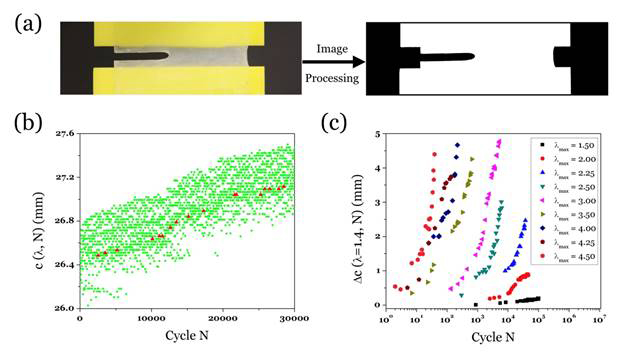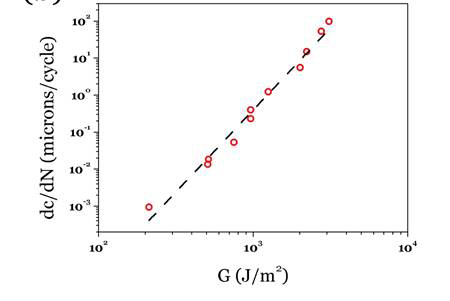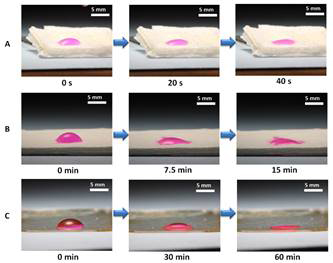Reports: DNI955379-DNI9: Thermo-Chemo-Mechanics of Swellable Elastomers
Shengqiang Cai, PhD, University of California, San Diego
Narrative Report
In the past year, supported by the ACS Petroleum Research Fund, we have mainly conducted experimental studies on (1) the fatigue behavior of stretchable elastomers and (2) mechanical behaviors of porous double network gels. In the following, we will report the results obtained by us in these two topics.
1. Fatigue of stretchable elastomers
Introduction
Dielectric elastomer has been extensively explored in various applications as soft active material. In most applications, dielectric elastomer is subjected to cyclic loading-unloading condition. As a result, a small initial defect in a dielectric elastomer may finally grow to a critical size to induce catastrophic rupture. In the past year, we carried out an experimental study of the crack growth in an acrylic dielectric elastomer under cyclic loading-unloading. Pure-shear test specimens were used to measure the relationship between crack growth rate and energy release rate. Such relationship can be simply fit to a power-law. We further used the measured power-law to successfully predict the fatigue lifetime of the acrylic elastomer with an edge crack and subject to simple extension cyclic loading-unloading test.
Experiments
In the experiments, acrylic elastomer film VHB 4910 was purchased from 3M Company. The VHB films were cut into different shapes for pure-shear test and simple extension test. Samples of both geometries were cyclically loaded-unloaded with and without a pre-cut as shown in Figure 1. A computer-controlled-camera system was used to record the crack growth process in the pure-shear specimen with a pre-cut.
Fig. 1. Schematics of a VHB film subject to cyclic loading-unloading test. (a) A pristine VHB film under pure-shear test in undeformed state and deformed state; (b) A pre-cut VHB film under pure-shear test in undeformed state and deformed state; (c) Cyclic loading-unloading test with stretch rate: 1.8/s.
Results
· We have obtained the crack growth rate of a VHB film subject to cyclic loading-unloading with different maximal stretches as shown in Figure 2.
Fig. 2. Crack growth in a pre-cut VHB film subject to cyclic loading-unloading test. (a) For a pre-cut pure-shear VHB sample, photos are transferred to Black and White form to measure the crack length and calculate stretch; (b) A pre-cut pure-shear VHB sample subject to cyclic loading-unloading test with lmin ¼ 1.2 and lmax ¼ 2, and crack length c varies with stretch l and cycle number N. Green dots represent the crack length change in all stretches with different cycle number N. Red triangles represent the crack length change around stretch l ¼ 1.4 with different cycle number N; (c) In different cyclic tests, crack length change Dc around stretch l ¼ 1.4 is selected and shown as a function of cycle number N. (For interpretation of the references to colour in this figure legend, the reader is referred to the web version of this article.)
· We have obtained the power-law relationship between energy release rate and crack growth rate in VHB film as shown in Figure 3.
· We successfully predicted the fatigue life time of a VHB film with a small crack and subject to simple extension.
Fig. 3. The measured power-law relationship between energy release rate and crack growth rate.
Fig. 4. The comparison between the prediction and measurements of fatigue life time of a VHB film subject to cyclic loading.
2. Porous double network gels
Introduction
Using freeze-dry method, we fabricated porous double network gels with high toughness, high stretchability and fast solvent-absorption. When the freezing temperature was -20 °C and freezing time was 24 hours, pores with diameter around 300 μm could form in the gel. When the freezing temperature was lowered to −196 °C and freezing time was reduced to 10 minutes, monodisperse pores with diameter around 15 μm could form in the gel. We found out that both porous gels fabricated in different conditions can absorb solvent much more as well as much faster than nonporous gel. Furthermore, we found that the rupturing strain, stiffness and strength of the porous double network gels were all comparable to nonporous double network gel when containing the same amount of solvent. The unique combination of mechanical properties of porous double network gel may motivate new explorations of gels in practical applications.
Experiments
Double network hydrogel was prepared based on the method described in the literature with minor modifications. The double network gel was removed from the mould after fabrication, and then frozen at -20 oC for 24 hours, or frozen under liquid nitrogen (−196 °C) for 10 minutes; after which, the frozen samples were transferred into a freeze-drier (Labconco freeze-dry system) for complete lyophilization, and the dry macroporous and microporous polymer matrix were generated.
Results
· Figure 5 shows the microstructure of the porous gel.
Fig. 5. Photographs of double network polymers with different microstructures: (A-1) macroporous double network polymer, (A-2) microporous double network polymer, and (A-3) nonporous double network polymer. SEM images of surface of double network polymers with different microstructures: (B-1) macroporous double network polymer, (B-2) microporous double network polymer, and (B-3) nonporous double network polymer.
· Figure 6 Demonstrate the fast absorption rate of porous double network gel.
Fig. 6. One drop of dyed water was dripped from the pipette onto the surface of (A) dry macroporous polymer, (B) dry microporous polymer, and (C) dry nonporous polymer.
Figure 7. shows the excellent mechanical performance of porous double network gels.
Fig.7. Stress vs. stretch curves for various double network gels under simple extension text. (A) Stress vs. stretch curves for gels containing 4 times its own weight of water; (B) Stress vs. stretch curves for gels containing 9 times its own weight of water; (C) Stress vs. stretch curves for gels containing 14 times its own weight of water; (D) Stress vs. stretch curves for gels containing 19 times its own weight of water.


















